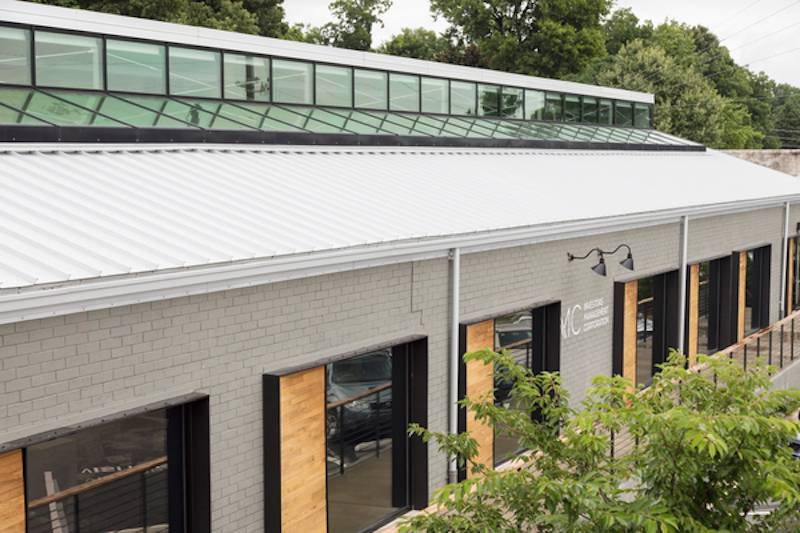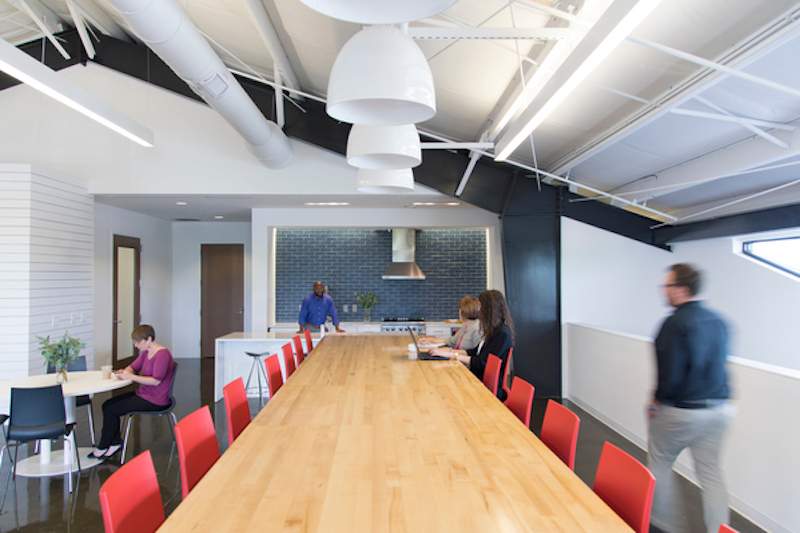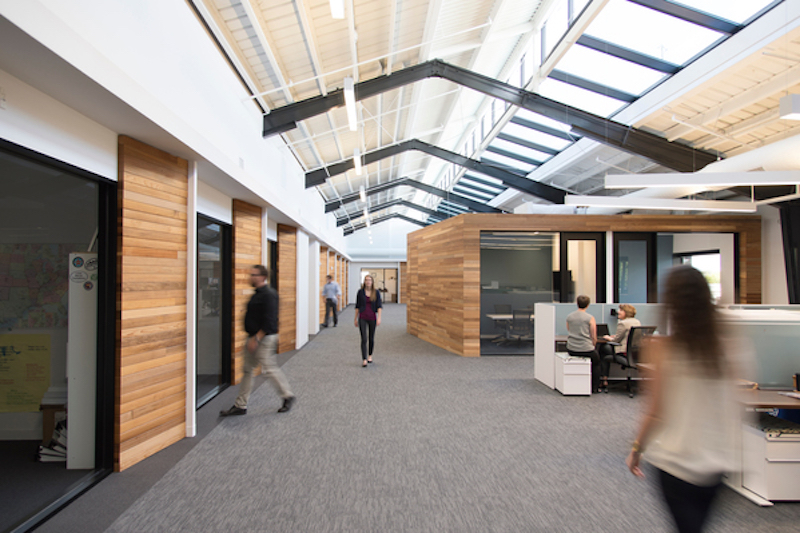Raleigh, N.C., is in the midst of a development boom. Since 2005 through July of this year, this metro has added 3,672 residential units, 1,000 hotel rooms, 346,000 sf of retail space and 1.5 million sf of office space downtown.
The Raleigh-Durham metroplex has seen more than $3.3 billion of investment in 250 miles of highway infrastructure, $3.2 billion last year in new capital investments, and more than 30,000 new jobs announced in 2016.
One of the companies that’s been part of this boom is Investors Management Corporation, a small investment firm that purchased a 16,000-sf building from CE Rental that once served as a storage facility for dishes, tables and dining products, with the intention of converting this space into IMC’s new headquarters.
“The entire district in which this building is located is undergoing massive change, with many old warehouses finding new life,” observes Michael Wagner, architect and Associate at the Raleigh office of Gensler, architect and designer on IMC’s adaptive reuse.
The IMC project is one of those case studies where location seemed to trump just about everything else. The building is on hilltop site that overlooks downtown Raleigh. But IMC had acquired a building that was a half-century old, prefabricated, uninsulated, and backed up onto a railroad line. Adding to this renovation’s complexity was the tight scheduling IMC required because the lease on the company’s old headquarters building was expiring.
“The client gave us a great charge in finding the ‘worst building with the best view.’ So we did,” says Chad Parker, Principal and Co-Managing Director at Gensler’s Raleigh office.
The Building Team—which included Optima Engineering (MEP), Lynch Mykins (SE), and Stewart (CE and landscape architect)—maintained the two-story building’s exposed structural members and cross bracing, as well as its existing brick façade. By limiting more elaborate changes to the building’s infrastructure, the team was able to use the North Carolina Rehabilitation Code and, therefore, save time and money.
“The intent from the start was to repurpose as many existing materials and finishes as possible.” recalls Wagner.
The location of this building informed its floor plan. Gathering spaces, initially intended for the lower levels, were moved to level two, where the design team added a large outdoor porch that creates a visual connection between IMC’s headquarters and the buildings within the city center and north of downtown.

A linear skylight and clerestory running along the north-south axis lets more natural light into the building. Image: Chris Leonard/courtesy of Gensler
Because the back wall of the building bumps up against the property line, building codes prohibited glass on the rear façade. So to bring more natural light into the building, the Building Team installed a linear skylight and clerestory along the length of the brick-clad, single-story volume. Large glass openings along the building’s east façade replace eight- by eight-ft rollup garage doors, creating a direct connection to the outdoors.
The building, which dates back to at least 1981 according to tax records, was pretty barebones before its recent transformation, according to Wagner. It had no insulation in the roof or the wall. Off-the-shelf metal wall panels on girts had no interior finishes. All masonry walls were single wyeth, without insulation.
The Building Team added insulation inboard to the exterior face of wall when new interior framing and sheetrock were installed. The brick and metal panels were painted, but all weatherproofing, including an air barrier and batt insulation, was handled on the interior side of the existing wall.
The existing metal roof was left in place, and now provides the substrate for a new roof system that includes R-30 polyiso insulation as well as a new standing seam galvalume metal roof.
 An open deck lets workers take a break outdoors and provides views of downtown Raleigh. Image: Chris Leonard/ courtesy of Gensler
An open deck lets workers take a break outdoors and provides views of downtown Raleigh. Image: Chris Leonard/ courtesy of Gensler
To open the volume within the space, the Building Team demolished a wood frame interior mezzanine and two full-height CMU partition walls running perpendicular to the overall geometry of the building.
It also removed an existing freight elevator, and filled the hole in the second floor slab. The new framing for this infill became the center of the new reception space on level one. The existing stairs to the second level were repurposed, rotated 180 degrees, and reattached to the existing slab edge on level two.
The entire interior received new finishes. And the existing concrete floor was leveled to bridge a 2-inch offset in floor slabs, the result of previous building additions. A new exterior egress stair was added to the building’s south end.

The gathering spaces within the headquarters were moved to the second level. Image: Chris Leonard/courtesy of Gensler
Wagner says that any further expansion to IMC’s new headquarters would have to be vertical and would also need to satisfy future parking demands on a site where parking is already limited.
This project was completed in early 2016. Several of IMC’s employees were allowed to move into the building the previous fall under a temporary certificate of occupancy. There are currently around 25 IMC employees working in the building.
Related Stories
Office Buildings | Sep 28, 2023
Structural engineering solutions for office-to-residential conversion
IMEG's Edwin Dean, Joe Gulden, and Doug Sweeney, share seven key focuses for structural engineers when planning office-to-residential conversions.
Adaptive Reuse | Sep 19, 2023
Transforming shopping malls into 21st century neighborhoods
As we reimagine the antiquated shopping mall, Marc Asnis, AICP, Associate, Perkins&Will, details four first steps to consider.
Adaptive Reuse | Sep 15, 2023
Salt Lake City’s Frank E. Moss U.S. Courthouse will transform into a modern workplace for federal agencies
In downtown Salt Lake City, the Frank E. Moss U.S. Courthouse is being transformed into a modern workplace for about a dozen federal agencies. By providing offices for agencies previously housed elsewhere, the adaptive reuse project is expected to realize an annual savings for the federal government of up to $6 million in lease costs.
Office Buildings | Sep 14, 2023
New York office revamp by Kohn Pedersen Fox features new façade raising occupant comfort, reducing energy use
The modernization of a mid-century Midtown Manhattan office tower features a new façade intended to improve occupant comfort and reduce energy consumption. The building, at 666 Fifth Avenue, was originally designed by Carson & Lundin. First opened in November 1957 when it was considered cutting-edge, the original façade of the 500-foot-tall modernist skyscraper was highly inefficient by today’s energy efficiency standards.
Adaptive Reuse | Sep 13, 2023
Houston's first innovation district is established using adaptive reuse
Gensler's Vince Flickinger shares the firm's adaptive reuse of a Houston, Texas, department store-turned innovation hub.
MFPRO+ Research | Sep 11, 2023
Conversions of multifamily dwellings to ‘mansions’ leading to dwindling affordable stock
Small multifamily homes have historically provided inexpensive housing for renters and buyers, but developers have converted many of them in recent decades into larger, single-family units. This has worsened the affordable housing crisis, say researchers.
Adaptive Reuse | Aug 31, 2023
New York City creates team to accelerate office-to-residential conversions
New York City has a new Office Conversion Accelerator Team that provides a single point of contact within city government to help speed adaptive reuse projects. Projects that create 50 or more housing units from office buildings are eligible for this new program.
Adaptive Reuse | Aug 31, 2023
Small town takes over big box
GBBN associate Claire Shafer, AIA, breaks down the firm's recreational adaptive reuse project for a small Indiana town.
Adaptive Reuse | Aug 17, 2023
How to design for adaptive reuse: Don’t reinvent the wheel
Gresham Smith demonstrates the opportunities of adaptive reuse, specifically reusing empty big-box retail and malls, many of which sit unused or underutilized across the country.
Adaptive Reuse | Aug 16, 2023
One of New York’s largest office-to-residential conversions kicks off soon
One of New York City’s largest office-to-residential conversions will soon be underway in lower Manhattan. 55 Broad Street, which served as the headquarters for Goldman Sachs from 1967 until 1983, will be reborn as a residence with 571 market rate apartments. The 30-story building will offer a wealth of amenities including a private club, wellness and fitness activities.

















